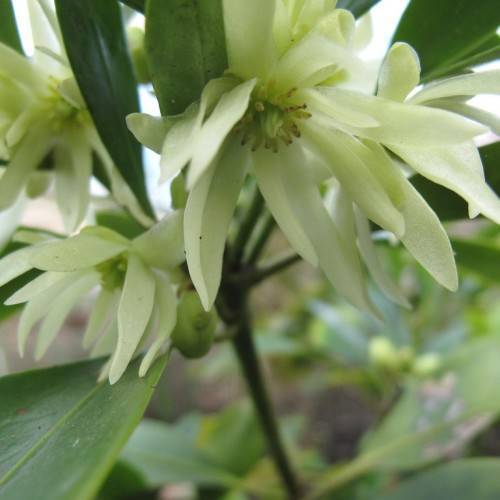
small anise tree
Illicium parviflorum 'Florence'
Cycle:
Perennial
Watering:
Average
Hardiness Zone:
7 - 10
Flowers:
Flowers
Sun:
Full sun,part shade
Leaf:
Yes
Growth Rate:
Low
Maintenance:
Moderate
Drought Tolerant:
Yes
Salt Tolerant:
Yes
Care Level:
Medium
watering
Small anise trees should be watered once a week, providing 1-2 liters of water each time. Water slowly and directly onto the soil so it absorbs better. Water more frequently during summer and less in winter. Make sure the soil drains well so the tree's roots won't be sitting in water. During any season, the soil should be moist but not soggy. Checking the soil before watering is the best way to judge if it needs more moisture. Always fertilize the tree once a month with a quality fertilizer to keep it healthy.
sunlight
The small anise tree (Illicium parviflorum 'Florence') prefers full sun exposure as it will help keep the soil consistently moist and promote healthy growth. This plant species does best in an area that receives 5 to 6 hours of direct sunlight daily, ideally during the morning and afternoon hours while avoiding the heat of the midday sun. During the spring and summer months, the small anise tree should receive a minimum of 6 hours of direct sunlight. During the cooler fall and winter months, however, the amount of sunlight can be reduced to 4 to 5 hours. By exposing the plant to this amount of sunlight, the small anise tree will be able to flower properly and gain the energy they need for photosynthesis and healthy growth.
pruning
Small anise tree (Illicium parviflorum 'Florence') should be pruned twice a year, in late winter or early spring, and again in early summer. In late winter or early spring, prune out any dead, diseased, or damaged branches and prune away any branches that may obstruct pathways or impinge on adjacent buildings. In early summer, prune back suckers, water sprouts, or too many upright vertical branches, but keep the natural form of the tree. Also prune branches that are crossing 1 another; to open up the interior of the tree and let more light and air in. Avoid pruning off of more than a third of the live growth each year. Additionally, be sure to disinfect pruning tools between cuts with rubbing alcohol or a solution of 10 parts water and 1 part bleach.
